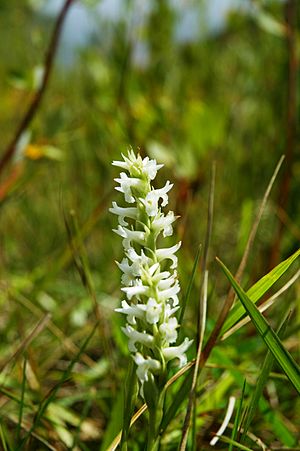Spiranthes diluvialis facts for kids
Quick facts for kids Spiranthes diluvialis |
|
|---|---|
 |
|
| Conservation status | |
| Scientific classification | |
| Genus: |
Spiranthes
|
| Species: |
diluvialis
|
The Spiranthes diluvialis is a very special and rare type of orchid. It is commonly known as the Ute lady's tresses. The name diluvialis means "of the flood," which hints at where it likes to grow.
This plant is found in the western United States. You can spot it in states like Colorado, Idaho, Montana, Nebraska, Nevada, Utah, Washington, and Wyoming. Recently, it was also found in southern British Columbia in Canada. This beautiful orchid is facing many dangers, which is why it is listed as a threatened species in the United States.
Contents
What is Ute Lady's Tresses?
This orchid is a plant that lives for many years. It grows a straight stem that can be 20 to 62 centimeters tall. Its long, narrow leaves grow around the bottom of the stem. They can be up to 28 centimeters long.
The flowers grow in a spiral shape on a stalk. This stalk is covered in tiny, sticky hairs. The flowers themselves are narrow and come in white or ivory colors.
Life Cycle and Reproduction
Ute lady's tresses usually blooms in July and August. Sometimes, it can even bloom into September or October. This plant can make new plants in two ways. It can produce tiny seeds, which are as small as dust. One plant can make 100,000 seeds!
Like other orchids, its seeds need special mycorrhizal fungi to help them grow. The flowers are pollinated by bees, especially a type of bee called Anthophora terminalis and bumblebees. The plant can also grow new shoots from pieces of its roots that break off.
Where the Ute Lady's Tresses Lives
This orchid loves wet places. It grows in wetlands, which are areas with lots of water. You can find it along riverbanks, in floodplains, near lakes, and in wet meadows. It also grows in places made by people, like ditches, reservoirs, and irrigated farm fields.
In 2005, there were about 52 known places where this orchid lived. It's hard to count exactly how many plants there are. This is because the plant often stays hidden underground. It might not grow any parts above the ground for years. This makes it tough to find and count them, even for experts.
Protecting the Ute Lady's Tresses
The Ute lady's tresses faces many dangers that threaten its survival. These threats often involve changes to its habitat.
Habitat Loss and Damage
When cities grow, like Salt Lake City and Colorado Springs, some orchid populations have disappeared. This is still a problem in many areas, including near Boulder, Colorado. City growth also brings new problems. Weeds can spread into the orchid's home, and important pollinating insects might disappear.
Building roads, dams, and pipelines also harms the orchid's habitat. Fun activities like boating and using off-road vehicles in wet areas can damage the plants too. Some orchids grow in farm fields. They can be harmed by mowing or when natural areas are turned into farms.
Water Changes and Invasive Plants
The orchid needs specific water conditions to thrive. Any changes to the water flow can hurt it. For example, water is often taken from rivers for farming or city use. This means less water for the orchid. Also, natural floods, which the orchid needs, are often stopped by levees. This changes the river habitat too much for the orchid.
Many invasive plants are also a big problem. These are plants that are not native to the area and can take over. They include plants like redtop, musk thistle, and purple loosestrife. These plants can crowd out the Ute lady's tresses.
Other Dangers
This orchid needs natural events like floods and occasional wildfires. These events help keep its habitat healthy. If floods are controlled and fires are stopped, the area can become too shady. Too many leaves can also build up, making it hard for the orchid to grow.
Animals like bighorn sheep and rabbits sometimes eat the orchid. The loss of pollinating bees is also a threat. This is because the orchid needs these bees to make seeds. Other dangers include dry weather, pesticides, and pollution. Sometimes, people even illegally collect the plants, which is called poaching.


